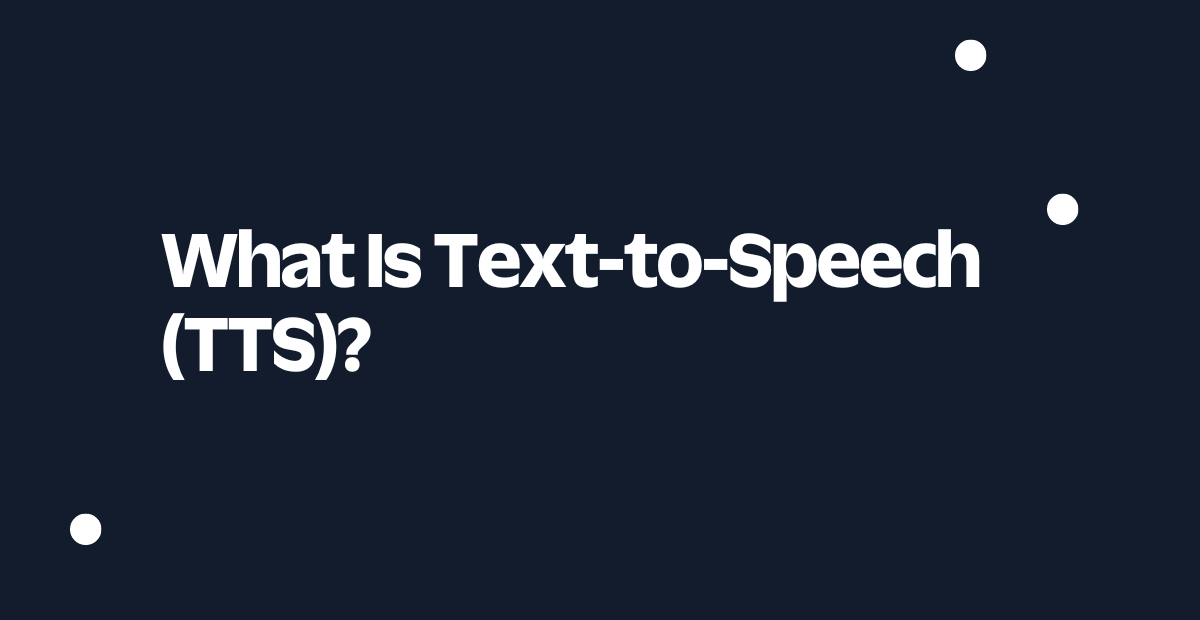What Is Text-to-Speech (TTS)?
Time to read:

A thought is only as useful as how you express it. One way people express their ideas is through text: ideas made readable. Whether with feather pens and parchment or through today’s instant SMS messages, text has always been a powerful documentation and communication tool.
Another way to give life to ideas is through speech: ideas made listenable. For a time, the human voice was the only way to facilitate speech. But today, machine learning and artificial intelligence (AI) enable devices and applications to replicate a human voice’s unique tones.
Text-to-speech (TTS) and the meaning of TTS technology is as simple as it sounds: technology that reads text aloud with an automated voice. Many devices and applications today offer TTS. It’s useful for listeners with visual impairment or language-based learning disabilities and can increase efficiency by allowing employees to multitask. In other words, TTS is a powerful productivity tool for organizations everywhere.
Here, we’ll cover how text-to-speech works, TTS tool types, and 3 ways TTS can benefit your business.
How does text-to-speech work?
Reading and inputting text are the most common ways users interact with applications and services on text-to-speech devices, such as desktop computers, smartphones, and tablets. If a Word doc, SMS message box, or web browser offers TTS capabilities, users can press a button or vocalize a command to convert text into computer-generated speech.
Some TTS technology tools allow the user to customize aspects of the program’s voice like:
- Gender
- Pitch
- Volume
- Reading speed
- Language
Other TTS technology offers multiple premade voices or reads in a distinctive voice—like Apple’s Siri, Amazon's Alexa, and the TikTok caption reader. Some photo applications also use a technology called optical character recognition to read aloud text found in images or video.
Types of TTS tools
Programs and services have myriad uses for TTS technology. As such, there are many different TTS tool types available on the market. In this section, we’ll explore some of the most commonly used types of TTS tools:
- TTS tools for operating systems (our friend, Siri, for instance) convert written text into spoken words across many types of digital content.
- TTS tools for applications add functionality to improve the user experience and expand accessibility. For instance, e-reader apps, like Amazon Kindle or Google Play Books, offer TTS that reads many digital books aloud.
- TTS applications like NaturalReader and Narrator’s Voice convert inputted text into automated speech with added features like pitch shifting, language translation, gender swapping, and audio file conversions to download and share.
- TTS tools for the web can read aloud text found throughout a website—serving as a virtual assistant for a person with visual impairment or translating a video’s speech into a different language, for instance. Companies can pay for this service to enhance website accessibility or individual users may opt for a similar service provided by companies like Google.
As you can see, there’s no one size fits all with TTS. You can choose one or more TTS tools depending on what makes the most sense for your organization. Next, we’ll get into specific use cases to help you narrow down the best solution.
Business use cases for TTS
Text-to-speech helps businesses create more engaging and accessible content that meets the needs of customers and employees alike. Here are 3 of the most common business use cases for TTS:
1. Multitasking
Say a colleague sends an SMS message containing the information you need for today’s big meeting, but you’re on the go. Messages are difficult to read while walking—especially through crowded spaces—and unsafe to read while driving. But stopping to read the message is cumbersome and time-consuming. What do you do?
Text-to-speech lets you pay attention to your primary task—like commuting, writing, or sketching—while listening to text converted into speech from your device. This empowers you to be safer and more aware of your surroundings without sacrificing productivity.
2. Visual impairments
People with visual impairments may struggle or be unable to read a device’s text. Others with eyestrain or computer vision discomfort may find exposure to screens uncomfortable. With text-to-speech, they can listen to text rather than burden themselves to read it.
Of course, screen visibility issues can impact everyone. For instance, when glares hinder a reader’s ability to read from their mobile device outside, TTS can vocalize on-screen text so they don’t have to find shade or increase the screen brightness. TTS, therefore, helps people make the most of their devices.
3. Translations
Language barriers can slow or halt business meetings, presentations, and day-to-day operations. For instance, when an organization’s international branch sends a document written in its native language, it can be costly and time-consuming to translate that business-crucial content.
Today, text-to-speech enables fast translation of foreign text into live speech that single receivers and groups alike can hear and understand. This streamlines your workflows by allowing your organization to focus less on logistical challenges from language barriers and more on initiatives that drive business growth. TTS can also help you deliver digital presentations to diverse stakeholders all around the world.
Connect to wider audiences with text-to-speech from Twilio
With insights into the value of text-to-speech powered by AI and deep learning, you can deploy text-to-speech technology across your voice services to customize and improve customers’ interactions with your team. But first, you need the capability to make high-quality, private connections through global carriers—all while securing customer and company data to improve your caller reputation.
Twilio’s Programmable Voice API helps you build a compelling and scalable voice experience for customers. You can also customize your text-to-speech solutions with add-on features like interactive voice response and speech recognition to make short work of everyday tasks. Try it for free now.
Related Posts
Related Resources
Twilio Docs
From APIs to SDKs to sample apps
API reference documentation, SDKs, helper libraries, quickstarts, and tutorials for your language and platform.
Resource Center
The latest ebooks, industry reports, and webinars
Learn from customer engagement experts to improve your own communication.
Ahoy
Twilio's developer community hub
Best practices, code samples, and inspiration to build communications and digital engagement experiences.


